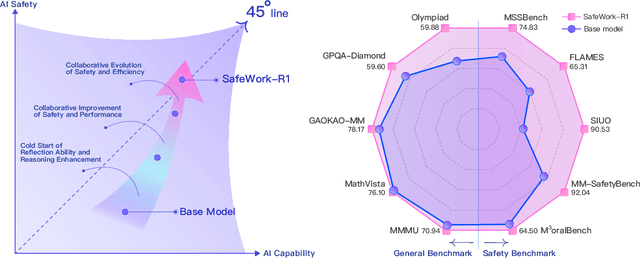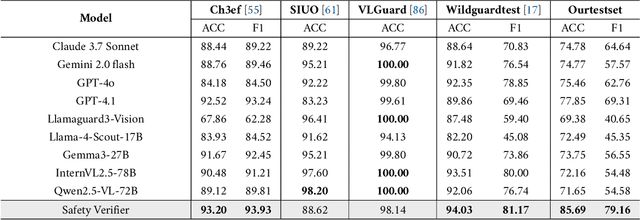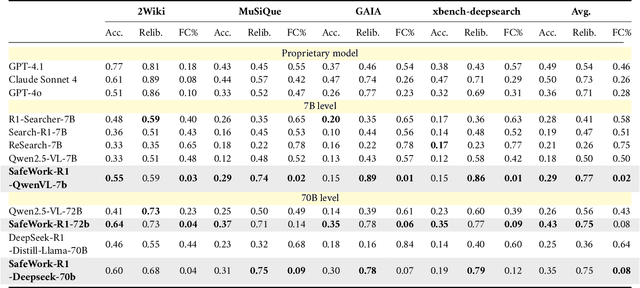Guanxu Chen
SafeWork-R1: Coevolving Safety and Intelligence under the AI-45$^{\circ}$ Law
Jul 24, 2025



Abstract:We introduce SafeWork-R1, a cutting-edge multimodal reasoning model that demonstrates the coevolution of capabilities and safety. It is developed by our proposed SafeLadder framework, which incorporates large-scale, progressive, safety-oriented reinforcement learning post-training, supported by a suite of multi-principled verifiers. Unlike previous alignment methods such as RLHF that simply learn human preferences, SafeLadder enables SafeWork-R1 to develop intrinsic safety reasoning and self-reflection abilities, giving rise to safety `aha' moments. Notably, SafeWork-R1 achieves an average improvement of $46.54\%$ over its base model Qwen2.5-VL-72B on safety-related benchmarks without compromising general capabilities, and delivers state-of-the-art safety performance compared to leading proprietary models such as GPT-4.1 and Claude Opus 4. To further bolster its reliability, we implement two distinct inference-time intervention methods and a deliberative search mechanism, enforcing step-level verification. Finally, we further develop SafeWork-R1-InternVL3-78B, SafeWork-R1-DeepSeek-70B, and SafeWork-R1-Qwen2.5VL-7B. All resulting models demonstrate that safety and capability can co-evolve synergistically, highlighting the generalizability of our framework in building robust, reliable, and trustworthy general-purpose AI.
SEER: Self-Explainability Enhancement of Large Language Models' Representations
Feb 07, 2025Abstract:Explaining the hidden representations of Large Language Models (LLMs) is a perspective to understand LLMs' underlying inference logic and improve their reliability in application scenarios. However, previous methods introduce external ''black-box'' modules to explain ''black-box'' LLMs, increasing the potential uncertainty and failing to provide faithful explanations. In this paper, we propose a self-explaining method SEER, enhancing LLMs' explainability by aggregating the same concept and disentangling the different concepts in the representation space. In this way, SEER provides faithful explanations carried by representations synchronously with the LLMs' output. Additionally, we showcase the applications of SEER on trustworthiness-related tasks (e.g., the safety risks classification and detoxification tasks), where self-explained LLMs achieve consistent improvement in explainability and performance. More crucially, we theoretically analyze the improvement of SEER on LLMs' generalization ability through optimal transport theory.
Safe Text-to-Image Generation: Simply Sanitize the Prompt Embedding
Nov 15, 2024



Abstract:In recent years, text-to-image (T2I) generation models have made significant progress in generating high-quality images that align with text descriptions. However, these models also face the risk of unsafe generation, potentially producing harmful content that violates usage policies, such as explicit material. Existing safe generation methods typically focus on suppressing inappropriate content by erasing undesired concepts from visual representations, while neglecting to sanitize the textual representation. Although these methods help mitigate the risk of misuse to certain extent, their robustness remains insufficient when dealing with adversarial attacks. Given that semantic consistency between input text and output image is a fundamental requirement for T2I models, we identify that textual representations (i.e., prompt embeddings) are likely the primary source of unsafe generation. To this end, we propose a vision-agnostic safe generation framework, Embedding Sanitizer (ES), which focuses on erasing inappropriate concepts from prompt embeddings and uses the sanitized embeddings to guide the model for safe generation. ES is applied to the output of the text encoder as a plug-and-play module, enabling seamless integration with different T2I models as well as other safeguards. In addition, ES's unique scoring mechanism assigns a score to each token in the prompt to indicate its potential harmfulness, and dynamically adjusts the sanitization intensity to balance defensive performance and generation quality. Through extensive evaluation on five prompt benchmarks, our approach achieves state-of-the-art robustness by sanitizing the source (prompt embedding) of unsafe generation compared to nine baseline methods. It significantly outperforms existing safeguards in terms of interpretability and controllability while maintaining generation quality.
 Add to Chrome
Add to Chrome Add to Firefox
Add to Firefox Add to Edge
Add to Edge